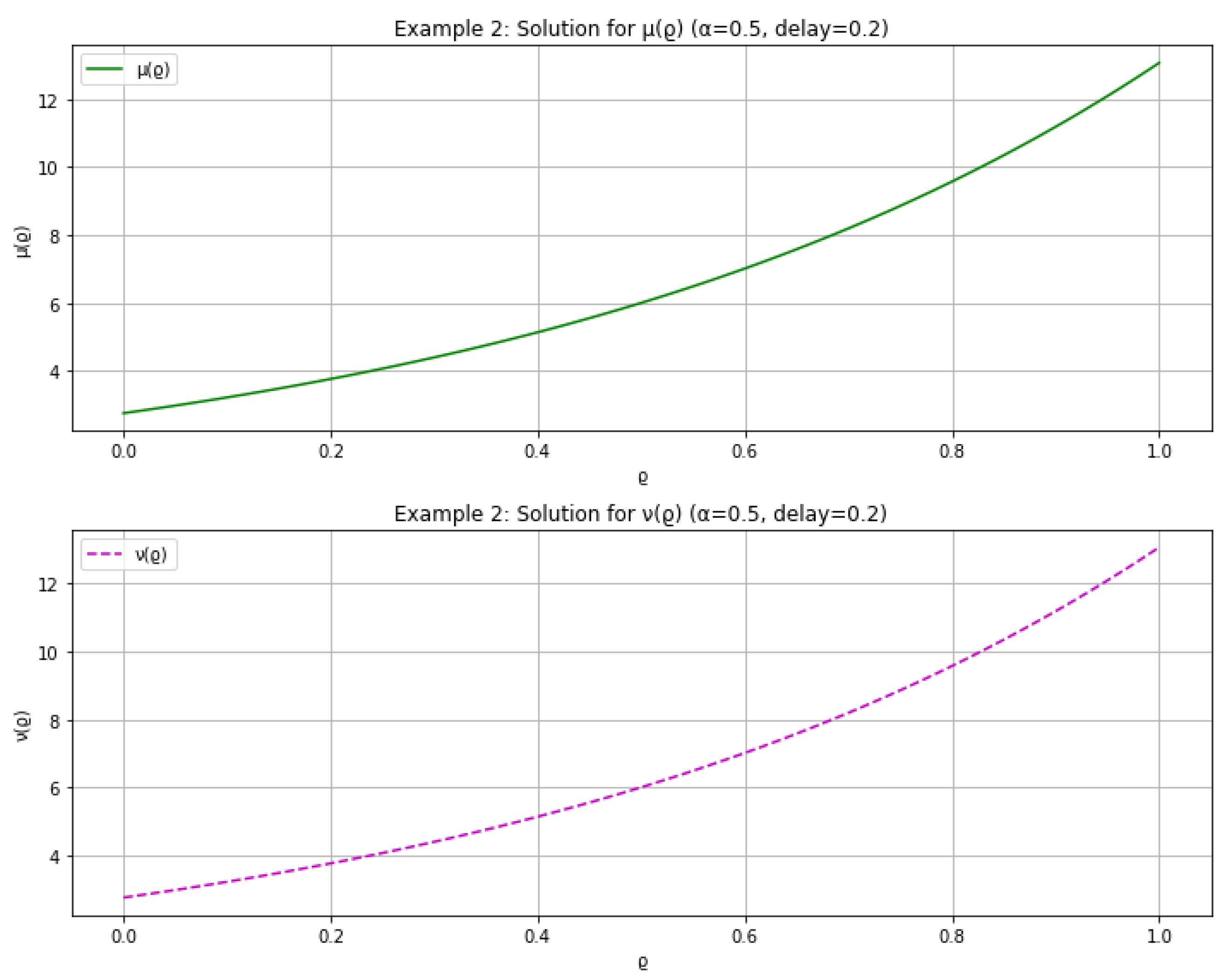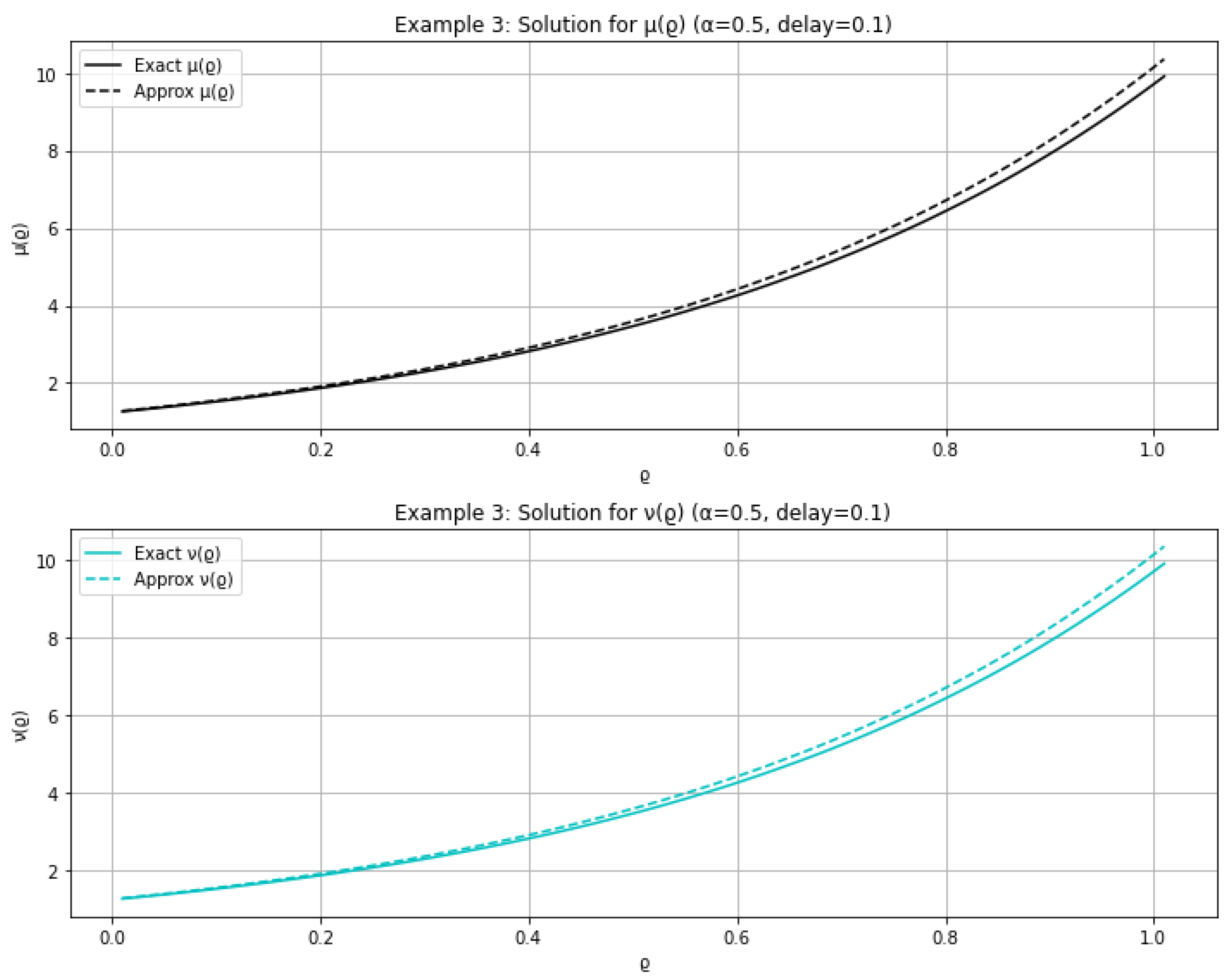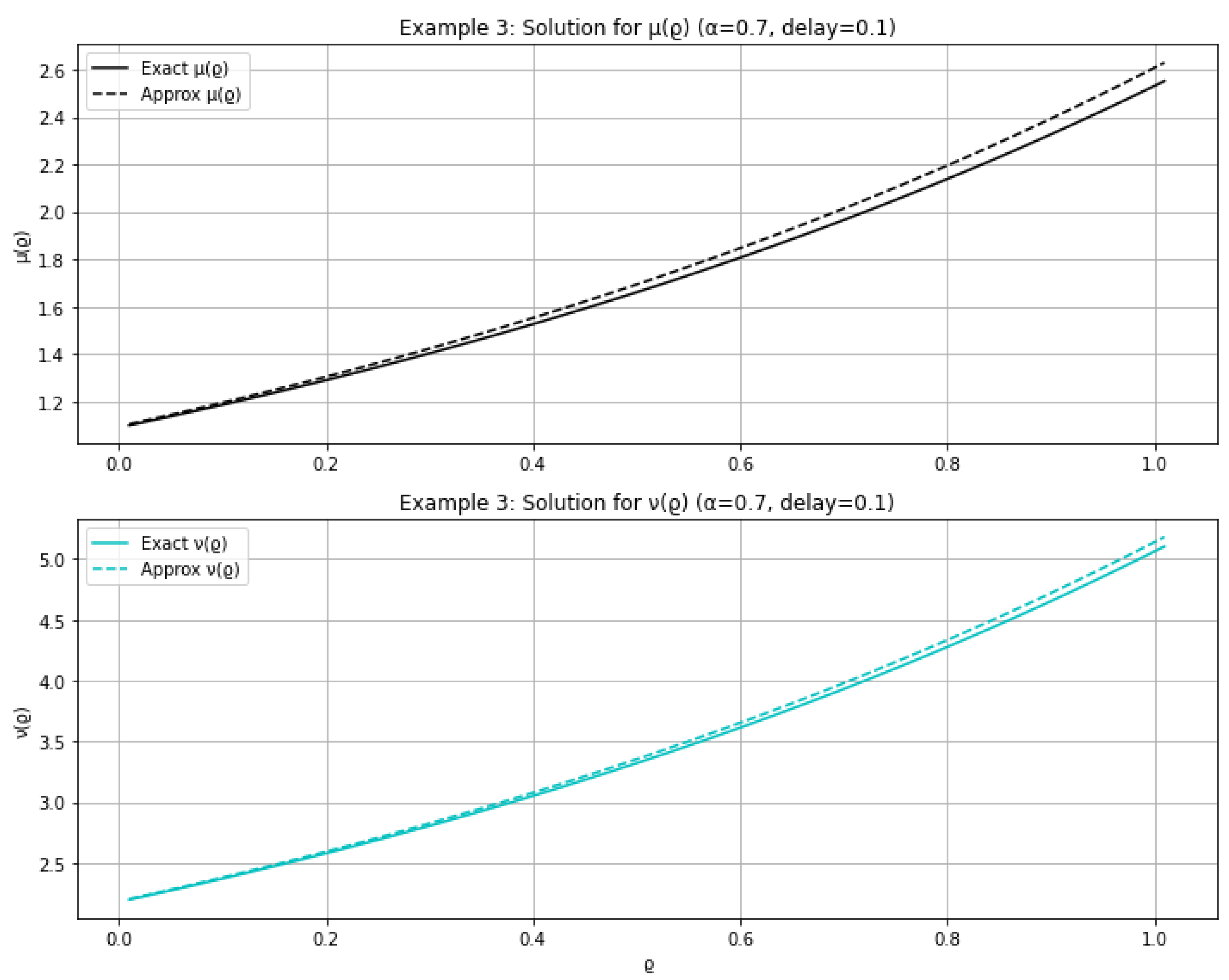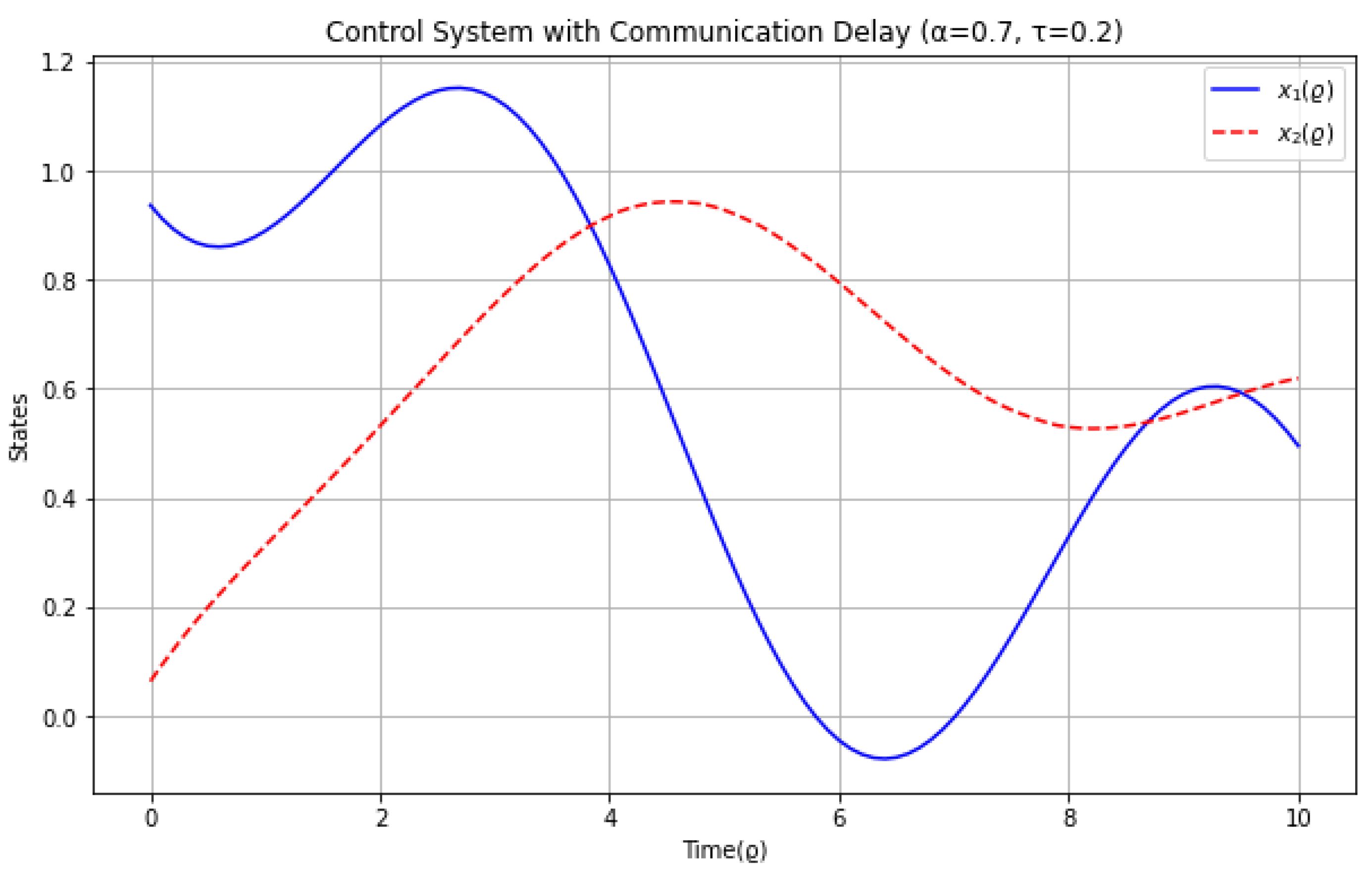Analyzing Coupled Delayed Fractional Systems: Theoretical Insights and Numerical Approaches
Abstract
1. Introduction
- and are the unknown functions and .
- denotes the CapFD of order with .
- and are given continuous functions.
- , , , and are given continuous delay functions satisfying,and .
- Theoretical Analysis: We establish the existence, uniqueness, and Ulam–Hyers stability criteria for the coupled system of CapFDEs with delays.
- Numerical Validation: We implement the Adams–Bashforth–Moulton method to numerically approximate solutions, reinforcing our theoretical results.
- Application: We demonstrate the practical applicability of our findings through a variety of illustrative examples, applications, and numerical simulations.
2. Preliminaries
3. Main Results
- (H1)
- For all and , we have the following:
- and are continuous.
- and are bounded: There exist constants such that
- (H2)
- The delay functions satisfy the following:
- for all .
- for all .
- (H3)
- are given continuous initial functions.
- (H4)
- For all and , and satisfy Lipschitz conditions, with constants such that for all ,
- Let . We show that is relatively compact via the Arzelá–Ascoli theorem.
- For , is constant and hence equicontinuous. By Arzelá–Ascoli theorem, is compact.
4. Examples
- For ,
- For ,
- For ,
- For ,
- Lipschitz constants: .
- Stability constant K:
- Error bound for an -approximate solution with :
5. Applications
5.1. Control Systems with Communication Delays
- The time domain is discretized into N steps of size .
- Predictor step: An initial estimate of the solution is calculated using the Adams–Bashforth fractional formula:where , , and .
- Corrector step: The estimate is refined using the Adams–Moulton fractional formula:where
- Delay handling: Delayed terms (e.g., ) are handled by interpolating historical data at .
5.2. Predator–Prey Dynamics
6. Conclusions
Author Contributions
Funding
Data Availability Statement
Conflicts of Interest
References
- Podlubny, I. Fractional Differential Equations: An Introduction to Fractional Derivatives, Fractional Differential Equations, to Methods of Their Solution and Some of Their Applications; Academic Press: Cambridge, MA, USA, 1999. [Google Scholar]
- Kilbas, A.A.; Srivastava, H.M.; Trujillo, J.J. Theory and Applications of Fractional Differential Equations; Elsevier: Amsterdam, The Netherlands, 2006. [Google Scholar]
- Samko, S.G.; Kilbas, A.A.; Marichev, O.I. Fractional Integrals and Derivatives; Theory and Applications, Gordon and Breach Science: Philadelphia, PA, USA, 1993. [Google Scholar]
- Miller, K.S.; Ross, B. An Introduction to the Fractional Calculus and Fractional Differential Equations; Wiley: New York, NY, USA, 1993. [Google Scholar]
- Caputo, M. Linear models of dissipation whose Q is almost frequency independent-II. Geophys. J. Int. 1967, 13, 529–539. [Google Scholar]
- Diethelm, K.; Ford, N.J.; Freed, A.D. A predictor-corrector approach for the numerical solution of fractional differential equations. Nonlinear Dyn. 2010, 29, 3–22. [Google Scholar] [CrossRef]
- Lakshmikantham, V.; Trigiante, D. Theory of Difference Equations: Numerical Methods and Applications; CRC Press: Boca Raton, FL, USA, 2009. [Google Scholar]
- Bai, Z. Fixed Point Theorems and Their Applications; Springer: Berlin/Heidelberg, Germany, 2017. [Google Scholar]
- Gambo, Y.Y.; Ameen, R.; Jarad, F.; Abdeljawad, T. Existence and uniqueness of solutions to fractional differential equations in the frame of generalized Caputo fractional derivatives. Adv. Differ. Equ. 2018, 2018, 134. [Google Scholar] [CrossRef]
- Ali, A.; Shah, K.; Jarad, F.; Gupta, V.; Abdeljawad, T. Existence and stability analysis to a coupled system of implicit type impulsive boundary value problems of fractional-order differential equations. Adv. Differ. Equ. 2019, 2019, 101. [Google Scholar]
- Abdalla, B.; Abdeljawad, T. On the oscillation of Caputo fractional differential equations with Mittag-Leffler nonsingular kernel. Chaos Solitons Fractals 2019, 127, 173–177. [Google Scholar]
- Ulam, S.M. A Collection of Mathematical Problems; Interscience Publishers: Geneva, Switzerland, 1960. [Google Scholar]
- Hyers, D.H. On the stability of the linear functional equation. Proc. Natl. Acad. Sci. USA 1941, 27, 222–224. [Google Scholar] [CrossRef] [PubMed]
- Khan, H.; Abdeljawad, T.; Aslam, M.; Khan, R.A.; Khan, A. Existence of positive solution and Hyers–Ulam stability for a nonlinear singular-delay-fractional differential equation. Adv. Differ. Equ. 2019, 2019, 104. [Google Scholar] [CrossRef]
- Baleanu, D.; Sadati, S.J.; Ghaderi, R.; Ranjbar, A.; Abdeljawad, T.; Jarad, F. Razumikhin stability theorem for fractional systems with delay. Abstr. Appl. Anal. 2010, 1, 124812. [Google Scholar]
- Ahmad, B.; Alghanmi, M.; Alsaedi, A.; Nieto, J.J. Existence and uniqueness results for a nonlinear coupled system involving Caputo fractional derivatives with a new kind of coupled boundary conditions. Appl. Math. Lett. 2021, 116, 107018. [Google Scholar] [CrossRef]
- Gorenflo, R.; Mainardi, F. Fractional Calculus: Integral and Differential Equations of Fractional Order; Springer: Berlin/Heidelberg, Germany, 1999. [Google Scholar]
- Mainardi, F. Fractional Calculus and Waves in Linear Viscoelasticity: An Introduction to Mathematical Models; Imperial College Press: London, UK, 2010. [Google Scholar]
- Younis, M.; Ahmad, H.; Ozturk, M.; Singh, D. A novel approach to the convergence analysis of chaotic dynamics in fractional order Chua’s attractor model employing fixed points. Alex. Eng. J. 2025, 110, 363–375. [Google Scholar] [CrossRef]
- Qaraad, B.; Bazighifan, O.; Ali, A.H.; Al-Moneef, A.A.; Alqarni, A.J.; Nonlaopon, K. Oscillation results of third-order differential equations with symmetrical distributed arguments. Symmetry 2022, 14, 2038. [Google Scholar] [CrossRef]
- Agarwal, R.P.; Baleanu, D.; Rezapour, S.; Salehi, S. The existence of solutions for fractional finite delay differential equations. Adv. Difference Equ. 2013, 2013, 1–9. [Google Scholar]
- Tunç, O.; Tunç, C. Existence, uniqueness and stability results for a coupled system of fractional differential equations with Hadamard fractional derivatives. Adv. Differ. Equ. 2021, 2021, 267. [Google Scholar]
- Ahmad, B.; Ntouyas, S.K. Existence results for a coupled system of Caputo type sequential fractional differential equations with nonlocal integral boundary conditions. Frac. Calc. Appl. Anal. 2014, 17, 348–360. [Google Scholar]
- Tunç, O.; Tunç, C.; Yao, J.C. New results on Ulam stabilities of nonlinear integral equations. Mathematics 2024, 12, 682. [Google Scholar] [CrossRef]
- Wang, J.R.; Zhang, Y. Ulam–Hyers–Mittag-Leffler stability of fractional-order delay differential equations. Optimization 2014, 63, 1181–1190. [Google Scholar] [CrossRef]
- Tunç, O. New Results on the Ulam–Hyers–Mittag-Leffler Stability of Caputo Fractional-Order Delay Differential Equations. Mathematics 2024, 12, 1342. [Google Scholar] [CrossRef]
- Butcher, J.C. Numerical Methods for Ordinary Differential Equations; John Wiley Sons: Hoboken, NJ, USA, 2008. [Google Scholar]
- Delboso, D.; Rodino, L. Existence and uniqueness for a nonlinear fractional differential equation. J. Math. Anal. Appl. 1996, 204, 609–625. [Google Scholar] [CrossRef]
- Zeidler, E. Nonlinear Functional Analysis and its Applications: I: Fixed-Point Theorems (Pt. 1); Springer: Berlin/Heidelberg, Germany, 1985. [Google Scholar]
- Atangana, A.; Baleanu, D. New Fractional Derivatives with Non-Local and Non-Singular Kernel: Theory and Application to Heat Transfer Model. Therm. Sci. 2016, 20, 757–763. [Google Scholar] [CrossRef]
- Caputo, M.; Fabrizio, M. A new definition of fractional derivative without singular kernel. Prog. Fract. Differ. Appl. 2015, 1, 73–85. [Google Scholar]






Disclaimer/Publisher’s Note: The statements, opinions and data contained in all publications are solely those of the individual author(s) and contributor(s) and not of MDPI and/or the editor(s). MDPI and/or the editor(s) disclaim responsibility for any injury to people or property resulting from any ideas, methods, instructions or products referred to in the content. |
© 2025 by the authors. Licensee MDPI, Basel, Switzerland. This article is an open access article distributed under the terms and conditions of the Creative Commons Attribution (CC BY) license (https://creativecommons.org/licenses/by/4.0/).
Share and Cite
Arab, M.; Abdo, M.S.; Alghamdi, N.; Awadalla, M. Analyzing Coupled Delayed Fractional Systems: Theoretical Insights and Numerical Approaches. Mathematics 2025, 13, 1113. https://doi.org/10.3390/math13071113
Arab M, Abdo MS, Alghamdi N, Awadalla M. Analyzing Coupled Delayed Fractional Systems: Theoretical Insights and Numerical Approaches. Mathematics. 2025; 13(7):1113. https://doi.org/10.3390/math13071113
Chicago/Turabian StyleArab, Meraa, Mohammed S. Abdo, Najla Alghamdi, and Muath Awadalla. 2025. "Analyzing Coupled Delayed Fractional Systems: Theoretical Insights and Numerical Approaches" Mathematics 13, no. 7: 1113. https://doi.org/10.3390/math13071113
APA StyleArab, M., Abdo, M. S., Alghamdi, N., & Awadalla, M. (2025). Analyzing Coupled Delayed Fractional Systems: Theoretical Insights and Numerical Approaches. Mathematics, 13(7), 1113. https://doi.org/10.3390/math13071113






